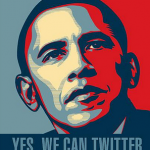In 2008, the Obama campaign made history by using Social Media to reach the public and affect the vote. The campaign set the bar for citizen outreach, especially because in 2008 using twitter for political means was not at all common. Now it is estimated that 39% of all adults use social media for political activism. Dr. Pamela Rutledge of The Media Psychology Blog points out that “The real power of social media is not in the number of posts or Tweets but in user engagement measured by content spreadability.” For example, Obama logged twice as many Facebook “Likes” and nearly 20 times as many re-tweets as Romney in the 2012 campaign.” Through social media, the Obama campaign had superior reach.
Read About the Obama Campaign Here
In a 2011 article in International Affairs Forum, 2013 volume 4 number 1 98-100 The author, Victoria Burton states “Social Media have facilitated government programs to carry out surveys and fine tune services, but perhaps the greatest aspect is that of public participation. Moving forward it will be important to address social media across public sectors and establish strategies to leverage its advantages and benefits.”
Because social media networks are always changing and growing, citizens no longer have to rely on traditional media to represent their views. Now instant communication via social media impacts almost every aspect of our lives. Relationships with local and city governments can be positively impacted by social media. In fact, many people now expect to be a part of the local government decision making process. Using social media effectively offers a way for city employees to collaborate with the general public at a rate never before possible.
On the local level Assistant City Manager, Kirsten Wyatt shared how Social Media affects citizen engagement in the City of West Linn. Last Saturday, our 510 class “Social Media for the Public Sector” enjoyed an entertaining presentation by Kirsten. She reported that West Linn uses Twitter, and Facebook for engagement, while their recently designed website informs people about programs, land use, department and contact information. In addition, the Twitter feed can be seen on the website. The City of West Linn strives to generate a two way “public opinion” conversation. To complete their citizen outreach goal, they use more traditional means of communication like pamphlets in Utility Bills, Flyers, and Cable TV to spread the word.
Whether we are considering a nationwide presidential campaign, or the day to day function of a local city government, we can not ignore the impact of social media. The way we reach citizens and the way we measure our success in citizen engagement is constantly changing, so any public employee charged with the task of managing social media must constantly evaluate the way social media is being used. “The Conversation” continues and it is the job of those employees to keep it current.


